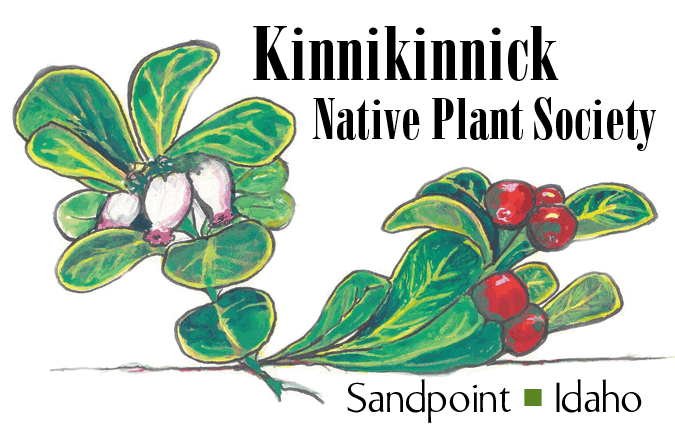Tall Oregon Grape
(Mahonia aquifolium)
Tall Oregon Grape flower
Meander the paths of the North Idaho Native Plant Arboretum and you're sure to spy the distinctive leaves of Oregon's state flower, Tall Oregon Grape (Mahonia aquifolium). The glossy green leaflets with sharp spines along their margin have been confused with English holly. The two share a genus name, aquifoluim, which means leaves with curved hooks like an eagle’s beak.
Tall Oregon Grape and the slightly less prickly, less shiny-leaved Creeping Oregon Grape (Mahonia repens) are Pacific coast natives from southern British Columbia to northern California stretching across eastern Washington to the Idaho panhandle and western Montana. Well adapted to drier, exposed sites, Creeping Oregon Grape is also found in New Mexico and Arizona. Its rhizotomatous roots and thicket forming habit make it a great native choice for restoration projects.
In April-May both Oregon Grapes exhibit showy sprays of small bright-yellow fragrant flowers in long-blooming displays that attract hummingbirds, bees and other pollinators.
Tall Oregon Grape fruit
Fruits ripen in September-October as clusters of dusky blue, round to oblong berries or "grapes,” hence its common name. The tart, blue fruits, sweeter after frost, provide a juice rich in natural pectin. The grapes produce wonderful jellies, jams, and wine if you can beat the birds to them! Indigenous people used the larger stems and roots to make a yellow dye used in woven baskets.
Tall Oregon Grape, a woody upright with slightly arching branches can reach 10 feet and spread from 4 to 12 feet, providing year-round interest as an accent plant or screen. Creeping Oregon Grape grows 9 to 15 inches tall spreading to three feet; perfect as a ground cover and in borders.
Spring growth in both is usually a bronzy red turning green in the summer. Cold winter weather or excessive sun can turn the foliage redish-purple. Long recognized as an outstanding landscaping choice, Oregon Grape prefers moist, rich, open sites, but tolerates shade and drought. Blend Oregon Grape into your landscape with other acid-loving shrubs and trees. Leaf spot may occur in too-wet conditions, but it is virtually pest and disease free.
Oregon Grape provides cover for many species and browse for deer, who will munch on the growing tips. Protecting new plantings until they are established will preserve your landscaped look.
At the main entrance and in the Dry Rock Habitat of the North Idaho Native Plant Arboretum, you'll find examples of Oregon Grape – tall and creeping. Open to the public, parking for the Arboretum is at 611 S. Ella Ave. or on the street.
Learn more about Oregon Grape on pages 93-95 of the KNPS publication, Landscaping with Native Plants in the Idaho Panhandle, available at local bookstores and the Bonner County History Museum.
Native Plant Notes are created by the Kinnikinnick Native Plant Society. To learn more about KNPS and the North Idaho Native Plant Arboretum, explore www.nativeplantsociety.org.


